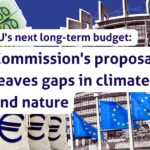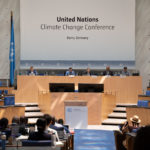The EU is not fulfilling its commitment to reduce emissions in line with the requirements of science and fairness. There is still a big gap between what it will take to avoid catastrophic climate change and what the EU has put forward in terms of climate action so far.
The EU’s pledge for the Paris climate summit, so-called Intended Nationally Determined Contribution (INDC) was signed off by the EU’s environment ministers in March this year. Its core is formed by the commitment by the EU’s member states from October 2014, to reduce greenhouse gas emissions by at least 40% by 2030.
CAN Europe regrets that the EU’s INDC does not indicate how the EU will move beyond 40% domestic emission reductions. For the EU’s pledge to be truly fair and adequate, it should reduce its greenhouse gas emissions by at least 95% by 2050. This means that the EU’s domestic emissions need to be reduced by at least 55% by 2030.
The Paris agreement needs to prevent locking in current, weak climate targets for 10 to 15 years. Therefore, the EU needs to advocate for a robust review mechanism in the agreement, one that will allow to strengthen all current, inadequate INDCs at latest by 2018.
Moreover, the EU needs to provide clarity and credibility to the pledge, by including information on the concrete amount of emission reductions that the EU will make after 2020.
The 2030 targets need to reflect the urgency of climate action
Analysis of the INDCs submitted so far shows that, if we do not revise them, the world is likely to warm by a devastating 2.7°C or more. Therefore, revision of the INDCs has to start just after the Paris summit and be concluded before the implementation begins, by at latest 2018.
Then, the pledges must be strengthened every five years. This means that the EU needs to translate its 2030 target into a commitment for 2025 as well. Short, five-year commitment periods – setting targets for 2025, 2030, 2035 and so on – are the most effective tool to regularly increase ambition to match scientific adequacy and technological breakthroughs. Moreover, all countries’ commitments must be synchronized by having the same end date. Otherwise we will lose comparability and political pressure created by successive negotiating rounds within the UNFCCC process.
The EU’s 2030 targets need to drive the transformation of the EU’s economy at a scale and pace needed to avoid the worst impacts of climate change. In order to achieve that goal, by 2030 the EU needs to reduce domestic greenhouse gas emissions by at least 55%, increase the share of renewable energy to at least 45%, and reduce projected energy consumption by at least 40%.
Policies that target climate change can help us achieve other important goals, such as human health, food and energy security, employment and environmental services.
The current EU’s 2030 climate target will by 2030 secure 70,000 new jobs, prevent 6,000 premature deaths annually and save EUR30 billion in reduced fossil fuel imports each year.
If the EU’s 2030 climate target was scaled up to deliver an economy powered fully by renewables by mid-century, already by 2030 it would secure around 420,000 new jobs in renewable energy sector, and prevent around 46,000 people from dying prematurely due to excessive exposure to air pollution each year. The EU would also save EUR160 billion annually thanks to reduced fossil fuel imports. Check our report on all these co-benefits of climate action.
The EU needs to tackle the lack of transparency and accuracy of its pledge for Paris
CAN Europe translated the EU’s 2030 target of at least 40% emission reductions into the exact amount of greenhouse gases the EU could emit between 2021 and 2030. The analysis reveals that depending on political choices that have been postponed for after the Paris summit, the EU’s “carbon budget” for the period from 2021 till 2030 will vary from 37 to 43 billion tonnes of greenhouse gases. This means a gap of a staggering 6 billion tonnes: substantially more than the EU’s current annual emissions (4.5 billion tonnes in 2012) and six times more than annual emissions from its transport sector (0.9 billion tonnes in 2012).
The EU needs to make its contribution to the climate agreement clear and comprehensive.In order to play a leadership role in the negotiations, it has to close the ‘gigatonne gap’ in its pledge.



